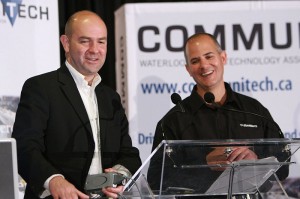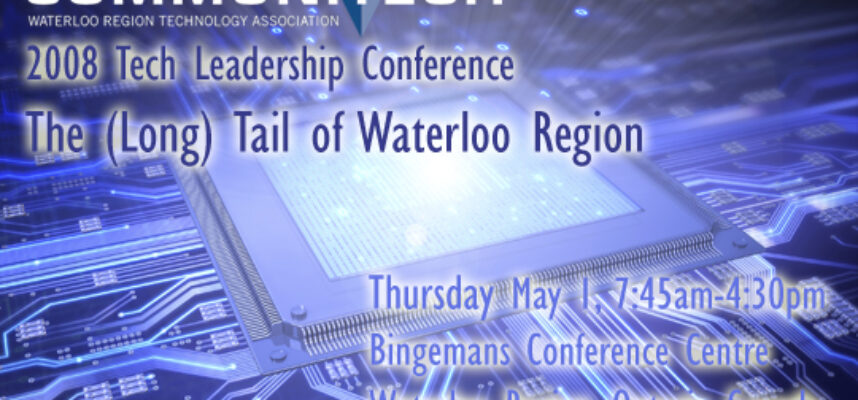6 May 2008
0 CommentsTech Leadership Redux
I finally found some time to record thoughts on a great conference – last Thursday’s Tech Leadership Conference (TLC) by Communitech.
CEO ROUNDTABLE:
Verdexus once again gathered a few tech CEOs from Waterloo and Toronto, the night before at Charbries, to have an informal and open-ended discussion of key issues in financing, growing, valuing and finding exits for technology startups.
As in past years, we assembled an accomplished group who have built primarily software-based businesses during the last decade and are now executing newer models, whether SaaS or the more esoteric Venture 2.0 Playbook necessary for “so-called” Web 2.0 and Mobile businesses. In an earlier blog, I covered a past TLC speaker and Verdexus advisor Grover RIghter’s Venture 2.0 Playbook.
Numerous war stories about increased complexities of dealing with founders, VCs, groups of angel investors, not to mention simply making enterprise sales highlighted common success factors of perseverence to overcome obstacles, failure and experimentation before ultimate success and just plain good luck around timing. The drying up of VC money and other funding challenges remain a constant theme.
Experience in building great businesses over the last ten years has a lot to teach us today. However, the 2008 market also demands significantly different startup building techniques. To explore that, we spent time dissecting the Web 2.0 phenomenon. Some key questions we analyzed were:
- Q: in building companies for less (e.g. under $10 million, or even $5 million, from start to exit), is this building a complete company? Or, is an exit to a much larger acquirer the only way such nimbly funded companies can be grown to full scale? A: yes and no, we had some quite different opinions on this, so perhaps the jury is still out.
- Q: likewise, are these companies inherently built around smaller applications, that aren’t as technologically deep as earlier startups, or is there a genuine breakthrough in company cost structures? A: yes there are real breakthroughs in outsourcing, virtualization, hardware and network costs, virtualizing management, etc. Furthermore, while some Venture 2.0 companies are big plays, many are ultimately just a piece of the whole product and will ultimately find their true “home” only when acquired.
- Q: in an age of “free”, what are the long term monetization strategies that will build companies of real value? A: see discussion around TLC and Chris Anderson, below.
In addition, we spoke about:
- the right time and stage to start going outside for money, and hence the tradeoffs between purely organic growth and the accelerated growth rates external finance allows.
- how to get and maintain, and perhaps legally incent, alignment between investors and management.
- the difficulties a “closed” mobile environment, particularly in Canada and the US, presents to startups and whether purely web-based applications (a la iPhone) represent the optimal rollout strategy. The emergence of 3G will only enhance this strategy (3G is expected to be 20% of handsets by 2010, but that number would be skewed to non-North American markets).
TECH LEADERSHIP KEYNOTES:
For anyone attending the May 1st Tech Leadership Conference, you can see that our roundtable discussions were right on point for what the US-based, most west coast and Web 2.0 focused speakers were telling the audience. In fact, it was striking how common the issues between the two back-to-back events turned out to be.
 First of all, Chris Anderson, editor of Wired, author the The Long Tail and most notably a past contributor to my favourite magazine, The Economist, spoke about the increasingly dominant role of FREE in product pricing strategies. Speaking from the perspective of an economist, Anderson illuminated why, increasingly, products and services, particularly those in the online digital realm, are moving to free or low cost pricing. He boldly predicted that “free is going to be the price of some version of any product”. First of all, the cost of production and distribution of these virtual products is primarily based on such inputs as computer processing power, network bandwidth, digital data storage, All of these are approaching zero or very low cost. Anderson underscored this by showing that the cost of serving video for 1 hour over the internet was about 1/4 cent per hour (and would be 1/8 cent per hour next year).
First of all, Chris Anderson, editor of Wired, author the The Long Tail and most notably a past contributor to my favourite magazine, The Economist, spoke about the increasingly dominant role of FREE in product pricing strategies. Speaking from the perspective of an economist, Anderson illuminated why, increasingly, products and services, particularly those in the online digital realm, are moving to free or low cost pricing. He boldly predicted that “free is going to be the price of some version of any product”. First of all, the cost of production and distribution of these virtual products is primarily based on such inputs as computer processing power, network bandwidth, digital data storage, All of these are approaching zero or very low cost. Anderson underscored this by showing that the cost of serving video for 1 hour over the internet was about 1/4 cent per hour (and would be 1/8 cent per hour next year).
This is important because basic economics teaches us that “in a competitive industry price will equal marginal cost.” At the very least, this means that competitive online markets will almost always involve competing with a free offering. Anderson presented a fabulous dissection of why this is true and the implications for business, and especially tech startups in fields like web, social media, mobile and digital media.
He spent less time on the monetization strategies startups should use to compete in these free-dominated markets. Although he presented the “freemium“ business model wherein 99% use a basic and free offering, while revenues come from the 1% who are most engaged and hence see the greatest value. However, as I’m engaged in real world exploration of these web 2.0 monetization strategies even as I write this, there is so much more to this critical topic. The previously mentioned Grover Righter Venture 2.0 playbook delves deep, exploring a hierarchy of monetization models, including mashups, text ads, video ads, carriage, points, subscription, vending, etc.
 Having already seen venture investor and advisor Chris Sacca doing a similar presentation at the Deloitte Predictions conference in January 2008, I will spend less time on his lunch time keynote. Sacca is an especially smart and engaging speaker and probably the best I’ve seen in sharing the Silicon Valley culture, expousing lessons learned during his recent work as head of special initiatives for Google.
Having already seen venture investor and advisor Chris Sacca doing a similar presentation at the Deloitte Predictions conference in January 2008, I will spend less time on his lunch time keynote. Sacca is an especially smart and engaging speaker and probably the best I’ve seen in sharing the Silicon Valley culture, expousing lessons learned during his recent work as head of special initiatives for Google.
The statistic that still resonates with me from his January talk was that Google is the largest purchaser of Filet Mignons in California. Having struggled over the years to import the Silicon Valley culture of focus and fun to Waterloo, I continue to wonder whether a direct import is possible given our differences of culture, climate and politics here in Canada. But, we this is definitely worth exploring and I’d really be interested in a Google employee’s analysis of the office and amenities in Waterloo compared to Mountain View.
On a deeper note, Sacca’s described his almost evangelical mission to lobby the FCC and help shape the subsequent 700 MHz spectrum to ensure it would be an open wireless platform. I’ve spoken a number of times about how broken our mobile environment is and that we need an improved regulatory framework and increased competition to get out of our current “dark ages”. In engaging the FCC, Chris has helped move the regulatory piece forward and with its Android open handset initiative, there is a good chance that Google will increase competitive intensity as well.
Lastly, Sacca weighed in on the topic of building new companies more efficiently and at the same time, took a swipe at VCs, in saying “traditional VC funds haven’t fathomed how cheap it is now to build a software company”. He continued that he “wouldn’t know how to be a VC, when you can start a company without maxing out a credit card”. Overstatement perhaps, but it does drive home the point we’ve been exploring for some time.
 The interplay of the two Chris’s (Anderson and Sacca) with later keynote Jeff Taylor (Eons, ex-Monster) and Rick Segal (venture parter at JLA Ventures) mashed up into a panel with maestro Mark Evans (PlanetEye, ex-National Post) moderating. Iain Klugman of Communitech is to be congratulated for putting this together. Never before have I seen so much mental horsepower and raw in the trenches experience on one stage. The panel, for which I believe Communitech plans to have a video stream available shortly, was a true highlight.
The interplay of the two Chris’s (Anderson and Sacca) with later keynote Jeff Taylor (Eons, ex-Monster) and Rick Segal (venture parter at JLA Ventures) mashed up into a panel with maestro Mark Evans (PlanetEye, ex-National Post) moderating. Iain Klugman of Communitech is to be congratulated for putting this together. Never before have I seen so much mental horsepower and raw in the trenches experience on one stage. The panel, for which I believe Communitech plans to have a video stream available shortly, was a true highlight.
 Again, major kudos to Communitech for pulling this remarkable event together. It is a real step forward for the Waterloo startup scene. To illustrate, less than three years ago, at October 2005 Entrepreneur Week, when Tony Perkins (AlwaysOn, founder RedHerring) spoke about many of the same Web 2.0 issues, the lack of readiness of the audience to receive this message was most apparent. The recent TLC dramatically shows that we’ve come a long way in those last few years in transitioning to the next generation of tech in Waterloo Region.
Again, major kudos to Communitech for pulling this remarkable event together. It is a real step forward for the Waterloo startup scene. To illustrate, less than three years ago, at October 2005 Entrepreneur Week, when Tony Perkins (AlwaysOn, founder RedHerring) spoke about many of the same Web 2.0 issues, the lack of readiness of the audience to receive this message was most apparent. The recent TLC dramatically shows that we’ve come a long way in those last few years in transitioning to the next generation of tech in Waterloo Region.











11 Jun 2008
0 CommentsEntrepreneurial Toolkit #2: “Don’t Drink Your Own Bathwater”
In the tech heyday of the mid-1990’s, my favourite US investment banker, Mark Slater (formerly of Hambrecht & Quist) had a strategy to avoid CEOs that, as he so eloquently put it, “Drank their own bathwater”. Mark had identified the tendency amongst CEOs, even entire executive teams, to become so satiated with the power and glitz of riding the waves of technology/media hype, that the corporate adulation goes straight to their head.
Ego and ambition, never faults in themselves, taken to extremes tend to cloud better judgment. Anyone who has visited their capital city, like Washington, London or Ottawa, has witnessed the same effect that all that marble and walnut lining the corridors of power have on newly elected Members of Parliament or Congress.
I’m sure all of us entrepreneurs have been seduced by the siren call of their own PR. I know I have. But long ago I learned that, no matter how big the entrepreneur’s ego, it is critical to be self analytical and have enough inner humility and judgement to resist the corrupting force of power and spin. Every company has faults, challenges and issues to deal with. In truth, no matter how great the press or the wave being ridden, no company can entirely escape the buffeting of real world forces and the ups and downs of a cruel world. Navigating such turbulent waters is simply another challenge entrepreneurs need to face every day.
One example, and a person I would consider a mentor and role model, is Ed Iacobucci, founder of Citrix Systems and more recently Dayjet. Ed, an industry visionary, pundit, technologist supreme with energy and a will to win, is a man for whom I have infinite respect. Specifically, Ed has weathered highs and lows like almost no one else I know. For example, when I first met him, he was CEO of an almost bankrupt startup selling multi-user OS/2 technology (go figure). Later, after re-targeting the Citrix product family around Windows NT, his company was a NASDAQ darling and on a roll.
Imagine being in Ed’s shoes when, at the February H&Q conference at the Westin St. Francis in San Francisco, he learned that Microsoft had just informed them that they were planning to compete with their core product, Ed led the charge with the team. First he did the honest thing and issued a press release, which had the effect of instantly wiping out over 80% of Citrix’s market capitalization. Without even going home, Ed flew straight to Redmond and led the 24×7 multi-month battle to save Citrix from being “Quickenized” by Microsoft. A $150 million deal saved the day, but the key fact was that Ed remained honest to himself and his shareholder base throughout, which is no simple task for a major public company given shareholder disclosure rules. Several years later, when his stock price touched $50, making Citrix worth a cool $20 billion, his only comment was a modest and realistic “that stock price is a lot to live up to.” Perhaps this illustrates why I have such admiration for Ed as an individual.
In summary, humility and being self critical (“not drinking your own bath water) coupled with fearless passion (the killer instinct and laser beam focus) are two of the most important qualities in the Entrepreneurial Toolkit. Well balanced, and taken together, they are a winning combination. Most importantly, like almost all personal success factors, they can and must be learned as only a rare few are born with this wiring.